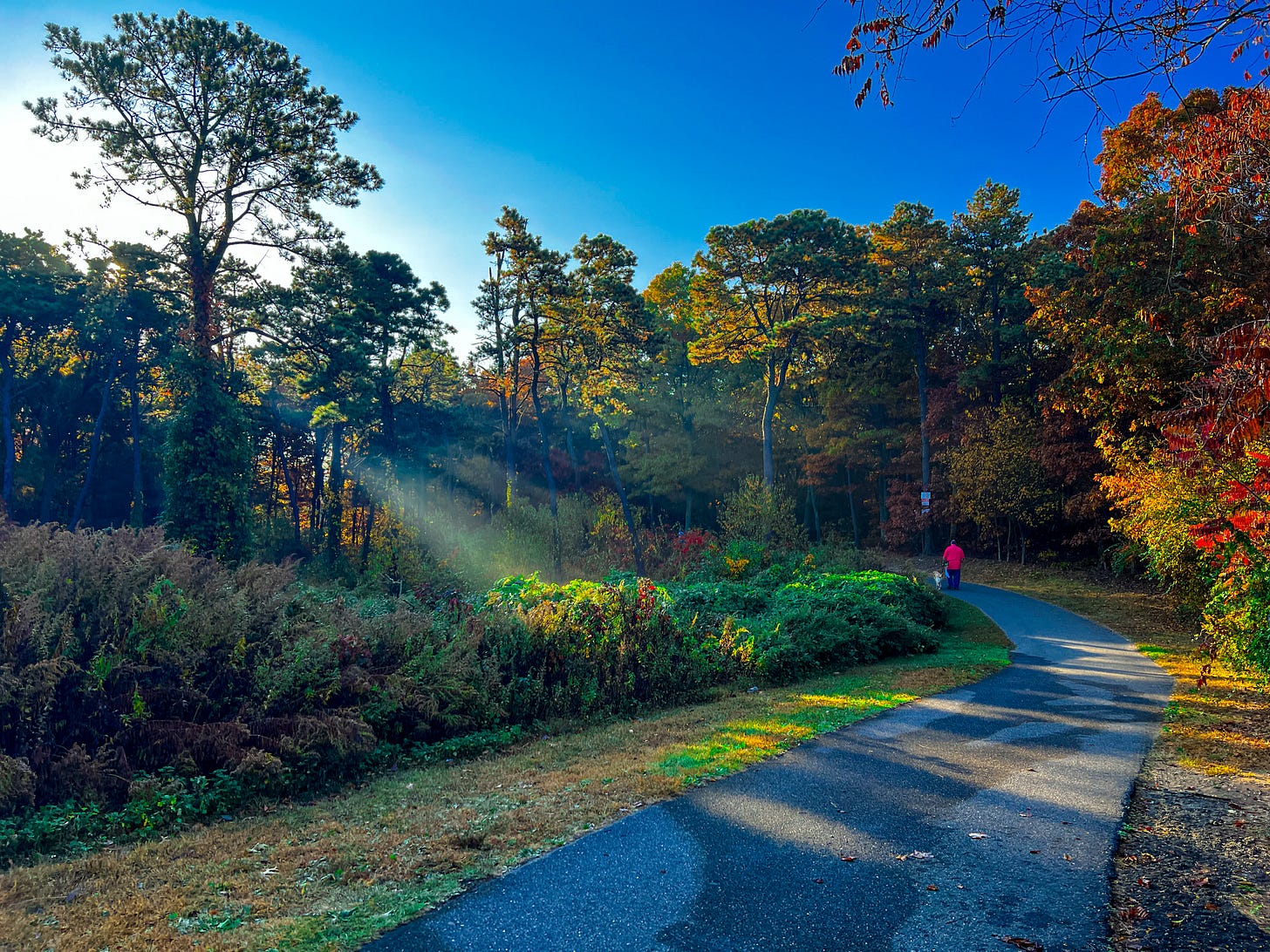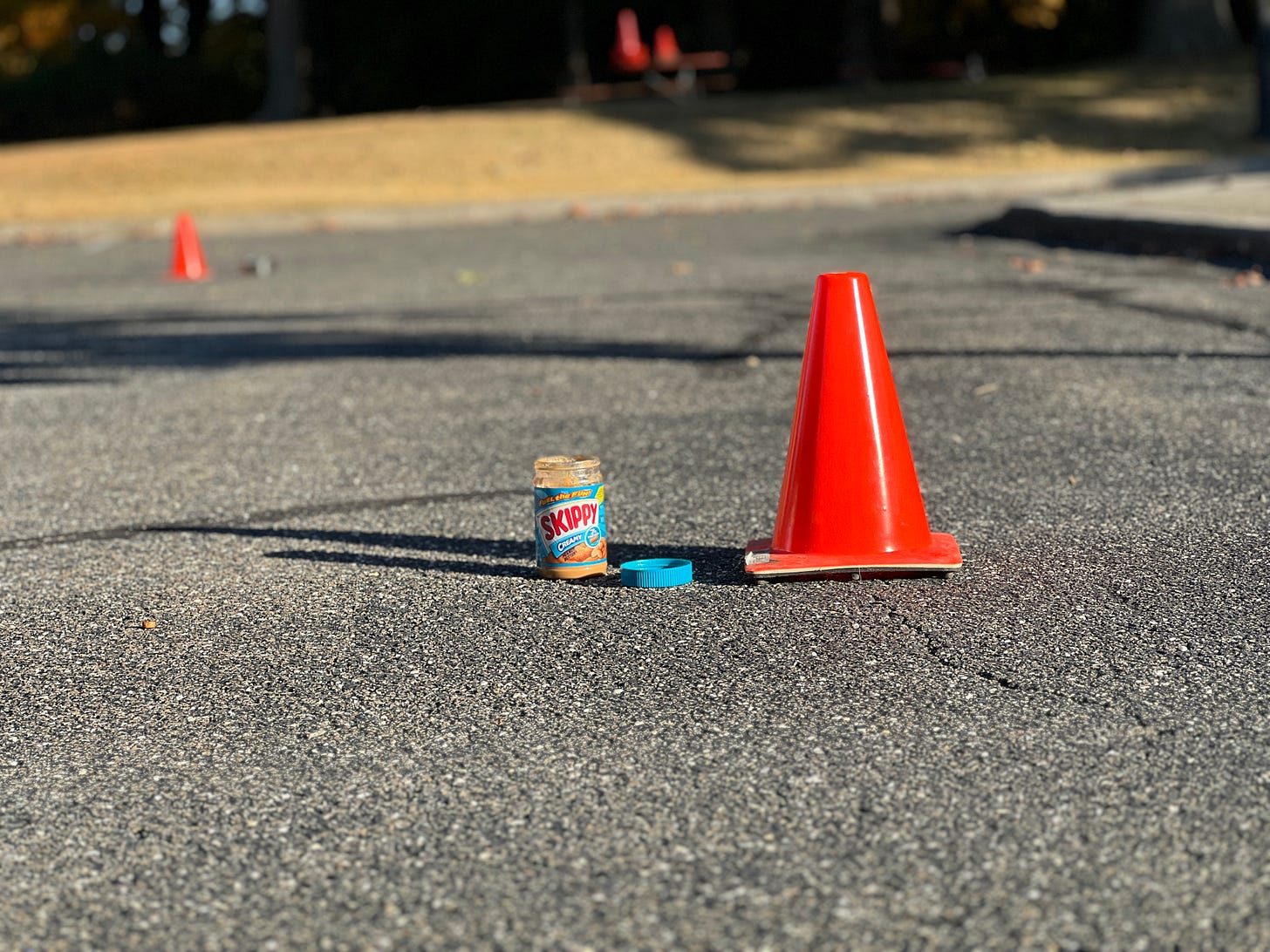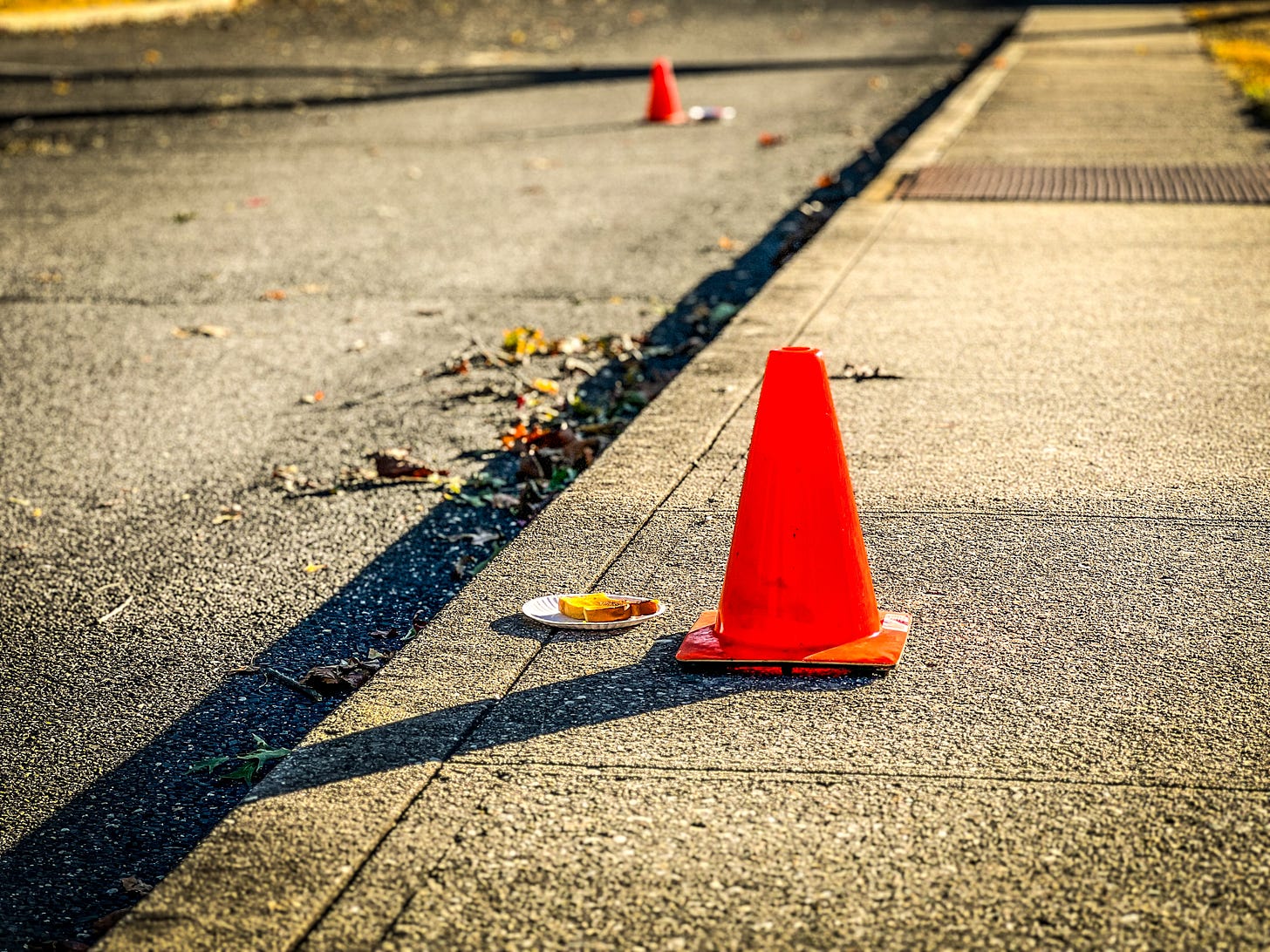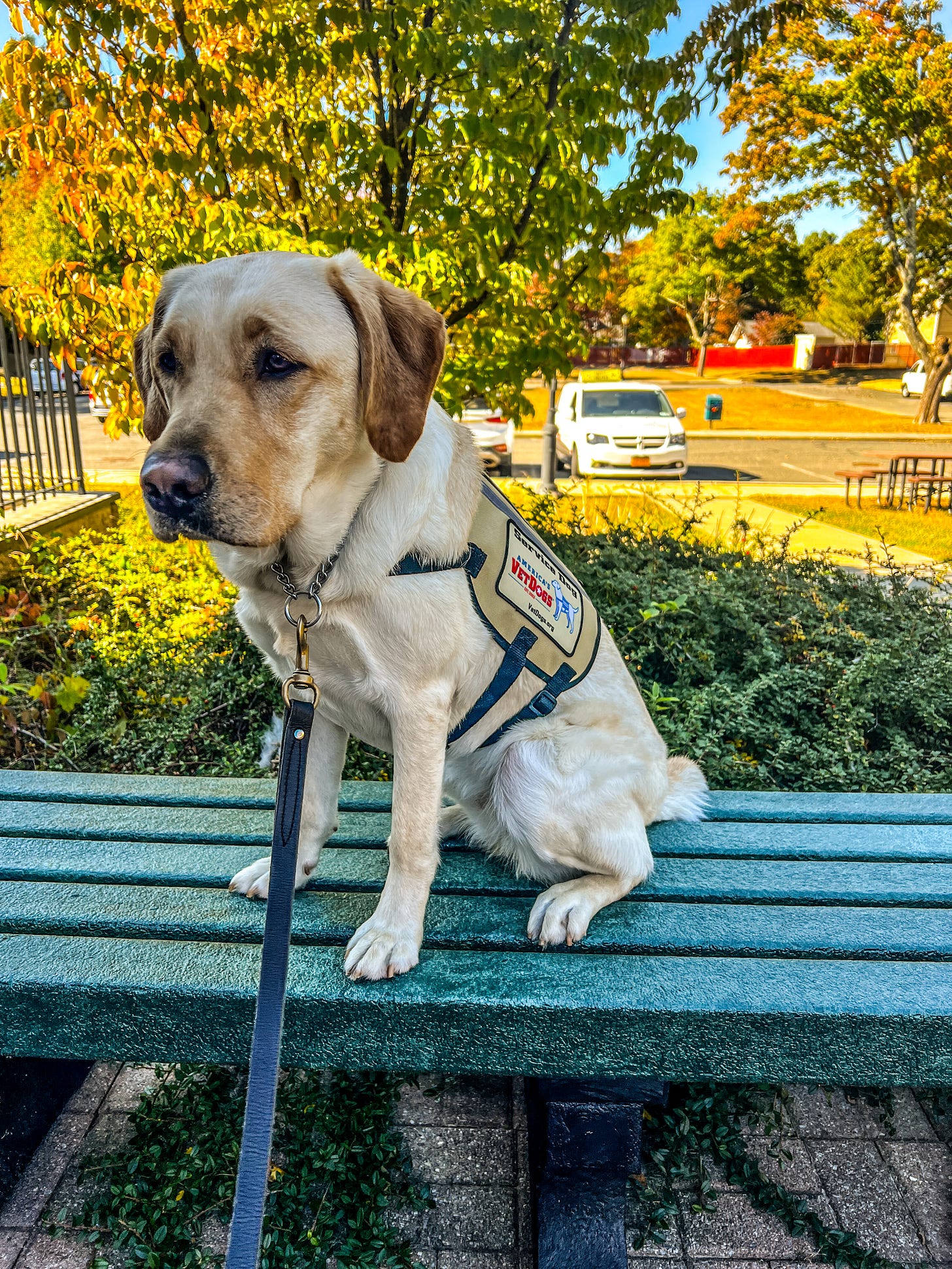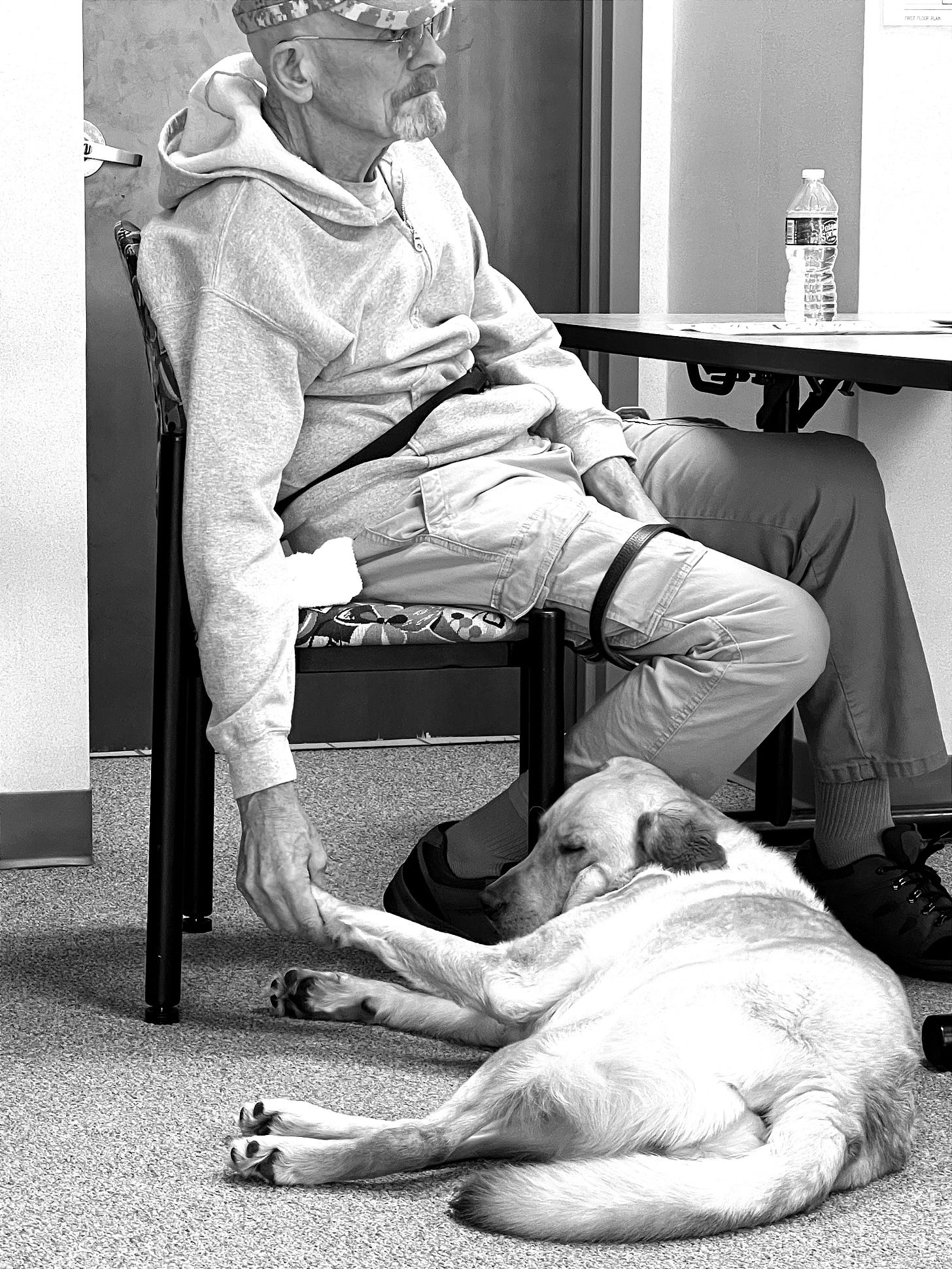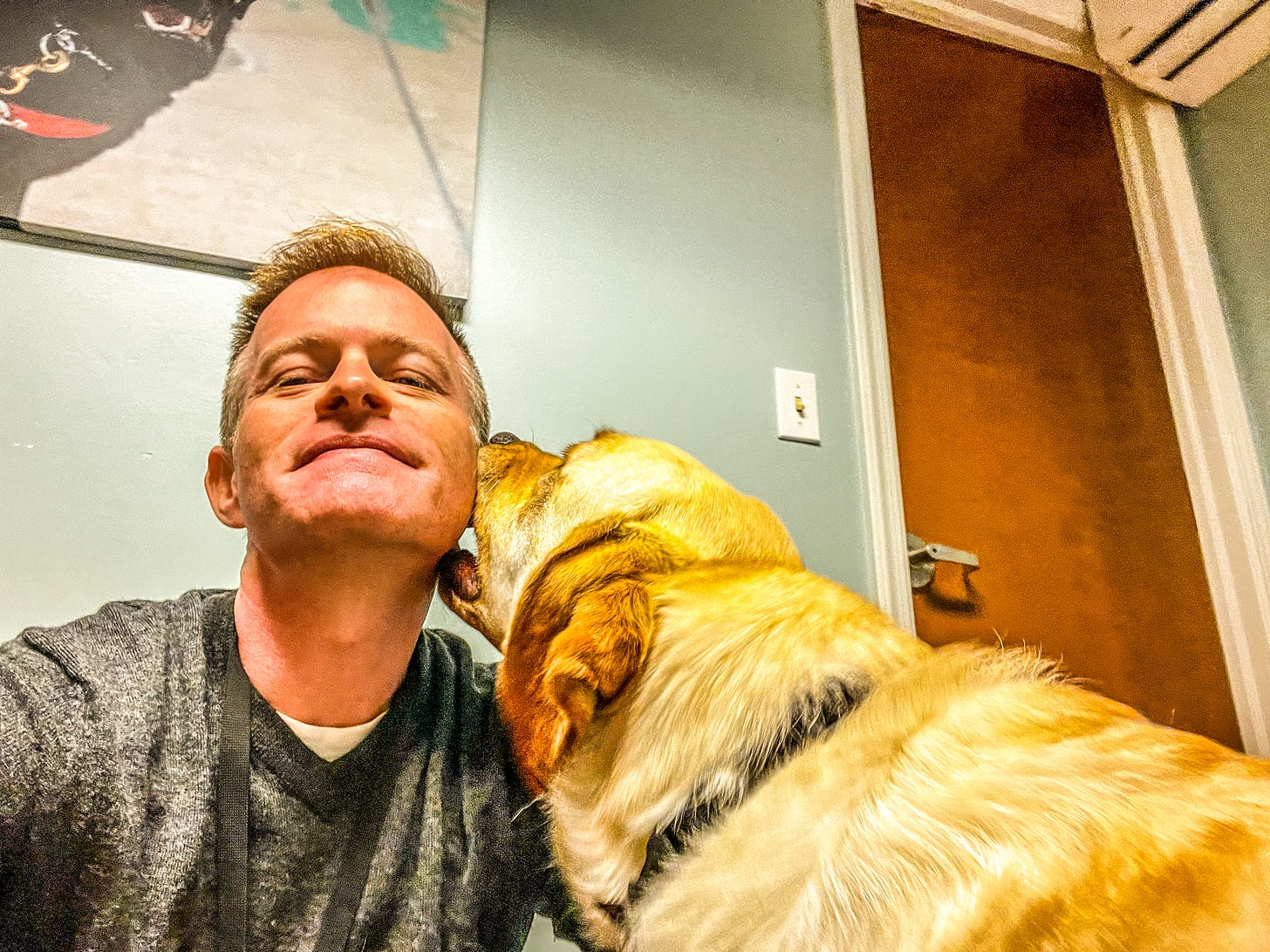About This Series
The Spirit of Recovery is a deeply personal account of my journey to receive and train with a PTSD service dog after a long wait and a longer struggle. Told in episodes, this series explores the awkward beginnings, emotional reckonings, and unexpected grace found in the process of learning to receive help. It’s about healing—not as a breakthrough, but as a quiet, daily decision to keep showing up.
New episodes every Monday at 10am.
I awoke to the soft rustling of fallen leaves skittering across the open lawn outside, carried along by a breeze I couldn’t yet feel. Inside, the room was still and dim, interrupted only by the gentle, rhythmic snores of a Golden-Labrador cross named Spirit. Our second full day together had been long—full of movement, emotion, and mental effort—and we had both collapsed into sleep the night before, spent in every sense of the word.
I rose and began my morning routine of exercise, eager to start the day off with a clear mind and a full heart. As mature and professional as she is in public, Spirit is not even two years old, and her youthful exuberance showed the moment I lowered myself to the floor to begin my morning exercise. With no hesitation, she interpreted my getting on the floor as an invitation to wrestle, and immediately launched into a flurry of excitement—bounding around me, smothering my face with kisses, snorting and wiggling and rubbing her warm body against mine. I tried to focus on pushups and planks, but my form was laughably compromised by a dog who clearly believed we were engaged in some kind of play. And maybe we were.
For all the hours she spends staring at me with laser focus, waiting for a command, aching to be useful, I welcome these bursts of unfiltered joy. They’re a sign she’s beginning to see me not just as a handler, but as her person. We’re forming a bond, slowly but surely—a partnership built not just on discipline and repetition, but on trust, affection, and shared space. We’re trying to become a team.
Breakfast was served by local volunteers whose thick Long Island accents gave the small dining room the feel of a bustling New York City deli. One of them had just retired from the NYPD after 30 years on the force. The other ran a daycare full-time and still found the energy to volunteer here once a week.
I do it because I like to help people, she said with a shrug. But mostly because of the dogs.
The spirit of service in this place is unlike anything I’ve ever experienced. It’s generous, relentless, and humbling. On our first day together, I noticed Spirit had a slight irritation in one of her ears—a small thing, but enough to raise concern. I mentioned it casually to my instructor, expecting it might be looked at later in the week. Within an hour, Spirit had been examined by the in-house veterinarian, a seasoned professional with over three decades of experience working with hundreds of service dogs a day. She was quickly diagnosed with a mild ear infection and given a week’s worth of medication—meaning she’ll be fully healed before we were scheduled to board the plane home.
It was handled so efficiently, so effortlessly, that I almost didn’t stop to absorb the weight of it: the medical care, like the dog herself, the housing, the food, the intensive training—every bit of it is provided to me at no cost. It’s all paid for through the donations of thousands of strangers I will never meet. And somehow, in the middle of the physical exhaustion, the emotional unraveling, and the mental fatigue of training, that realization hits the hardest.
I don’t feel like I deserve any of this.
What have I done to earn this dog, to earn the effort of these people?
The weight of it all presses down on me and makes me feel trapped. I am nervous and anxious like never before. I carry with me a sense of impending doom. My heart rate is elevated non stop. I cannot relax. I cannot be present and experience the simple joys of being in this place, surrounded by happy, well-balanced dogs with amazing training and huge hearts. I am like a zombie, a body walking through the day while my mind is elsewhere, grinding itself in fear without mercy or respite.
I press these thoughts out of my head and try to remember the many encouraging words of friends and family, hoping they will buoy me through these frequent bouts of self-doubt.
Although the mood at breakfast is mostly positive, there’s an undercurrent of concern that threads its way through our conversations—quiet admissions that betray the growing mental fatigue.
I just can’t seem to remember anything, one student confesses, staring into her coffee. It’s all so confusing. I keep giving the wrong commands and screwing everything up. The instructors are getting tired of me, I can tell.
Another chimes in with a weary smile: My dog is just so energetic. I don’t know how I’m ever going to keep up with her.
A third adds softly, I’m not sure my dog even likes me.
We sit at round tables with our dogs tucked underneath our chairs, each animal quietly facing the others in the small space beneath. Some dogs settle quickly and drift off to sleep. Others take the opportunity to sneak a few investigative sniffs at their neighbors. A few simply decide they’ve had enough of being still and stand up abruptly, forcing their handlers to go through the entire sequence of repositioning them under the table—again and again.
After the second or third time, you can see the toll it takes. Shoulders slump. Sighs grow heavier. Frustrated mutters slip out: Why won’t you just stay? Some handlers shake their heads, as if questioning their own ability to keep up. The rest of us offer quiet reassurances.
It’s okay, they’re still adjusting. You’re doing fine.
We say it to others, perhaps so we can hear it said to ourselves.
But in the back of everyone’s mind is the growing awareness that this—this chaos, this constancy, this full-time demand—isn’t temporary. In just over a week, we’ll be expected to navigate airports and fly home without supervision, fully responsible for dogs who will rely on us for structure, guidance, and calm every moment of the day. It’s a sobering realization: training doesn’t end here. It begins here.
You are not here to pick up a dog, our instructors reminded us on the first day. You are here to learn how to be professional, full-time dog handlers. When you leave here, you will be a professional service dog team.
Today, more than ever, the weight of those words settles over us. The tasks are growing more complex, the training days longer. There is less hand-holding now, more autonomy—more room to stumble, more pressure to rise.
A Day’s Activities
The entire class headed out for 45 minutes of focused heel work. A brisk October breeze swept across the open training range, stinging the tips of our noses and ears, carrying with it the sharp scent of pine needles and the earthy dampness of morning dew. The simulated city blocks of the training grounds buzzed to life, suddenly filled with pairs of handlers and dogs moving in tandem in all directions—some confidently, others more hesitantly—under the vigilant watch of our instructors.
Enthusiastic dogs, thrilled by the chance to move and work, predictably pulled forward, testing the resolve of tired handlers. Some voices rang out with frustration, others with encouragement. The instructors, stationed in the central green like sentries, called out corrections and guidance with calm authority, pivoting slowly in place like lighthouses scanning a busy harbor, ensuring no team drifted too far off course.
Spirit and I fell into our usual groove. She slid easily into a tight heel, her gait smooth and steady beside me. Every few steps, she tilted her head up toward mine, brown eyes bright, tongue lolling slightly in a dog-smile that said, We’ve got this. She was attentive, eager, joyful—and just as glad to be working beside me as I was to have her there.
If only I could say I felt the same. A growing tension mounted in me, brought on by a flurry of fears:
Can I do this long term?
Am I ready for this kind of commitment?
Can this dog keep up with my frequent travel schedule?
Is this a lifestyle I want to have at this stage in my life?
The instructors began upping the difficulty by placing small piles of food along the sidewalks—an intentional distraction to test our dogs’ focus and our ability to anticipate and manage it. As handlers, we’re expected to notice these temptations before our dogs do, to scan the path ahead like sentinels, identify the threat, and calmly issue the proper command to redirect our partners before instinct takes over.
Easier said than done.
Many of us struggled. The moment a dog caught sight—or scent—of the food, they lunged with the speed and intensity of a toddler spotting an unguarded cookie. Leashes snapped taut as the dogs attempted to vacuum up the scattered kibble like living Hoovers set loose in a cereal aisle. Frustration built in the handlers’ faces as instructors called out corrections, reinforcing the lesson: the distraction is real, but the responsibility lies with the handler to see it coming and prevent it.
And just when that challenge was beginning to take hold, a second layer was added: we were instructed to walk past one another, head-on, with dogs positioned on the inside—nose to nose, shoulder to shoulder, inches apart. If there’s one thing more distracting than food, it’s another dog. Especially one that’s excited, energetic, and equally new to this whole arrangement.
Tension crept through the ranks. You could feel it in the stiffened shoulders, the shortened leash grips, the nervous glances toward the instructors. Handlers tightened their focus, doing everything they could to keep their dog’s attention, whispering cues under their breath, offering quiet praise, bracing for a sudden pull or bark.
This wasn’t just a test of obedience—it was a test of endurance. Of sustained focus. Of managing your own anxiety so you can help your dog manage theirs. And as the exercises continued, it became clearer how much this training isn’t just about dogs. It’s about us. Our posture. Our presence. Our ability to stay calm when things go sideways.
Remember: tension goes down the leash! one of the instructors called out, her voice cutting through the crisp morning air. It’s a phrase we’ve heard countless times since training began, and for good reason—it’s one of the most important lessons of all.
You need to stay relaxed. Stay positive, she continued, pacing along the edge of the quad, eyes scanning the teams. You’re building a bond that will last a lifetime. At least PRETEND you want to be together!
The comment drew a few tired laughs, but the truth behind it was clear. Our dogs take their cues from us—every flicker of anxiety, every ounce of frustration, every unspoken doubt. It all flows straight down the leash like electricity. If we tense up, they feel it. If we waiver, they hesitate. If we check out, so do they.
And when you’re five or six days deep into this intensive training—physically sore, mentally foggy, emotionally frayed—relaxing on command starts to feel like just one more impossible task. But the dogs are always watching. Always waiting. And somehow, in their patient, eager eyes, we keep finding the strength to try again.
A Symbolic Milestone
Later in the day, after hours of drilling specific skills with our instructors—tight turns, focused heel work, precise responses to verbal and nonverbal cues—we reached a small but symbolic milestone: vesting our dogs for the first time.
One by one, we fastened the brown vests adorned with the corporate markings of the foundation over the shoulders of our canine partners. The act itself was simple—just a few straps and buckles—but its meaning wasn’t lost on anyone. This was our first official marker as a service dog team. The vest signaled more than just public access—it signaled responsibility, trust, and a growing identity.
For many of us, the moment stirred something deeper. We’d been sweating through the grind of training for days now, doubting ourselves, second-guessing commands, feeling frayed at the edges. And yet, here we were, standing next to dogs wearing the same emblem that seasoned teams wear in the real world. We were no longer just students. We were becoming handlers.
The mood shifted. Pride settled over the group like a warm breeze. Conversations bubbled up again—laughs, congratulations, the retelling of small victories from earlier drills. The room, once silent with nerves and fatigue, now filled with an almost childlike excitement as we posed for class photos, dogs seated obediently by our sides, each of us grinning despite the weight of the day.
After finishing our chicken salad sandwiches and wiping crumbs from our laps, we headed back outside for the final training block. The late afternoon light painted long shadows across the grounds, the cobalt sky above hinting at the coming evening chill. We worked through a series of increasingly complex tasks—loading into vehicles, walking on unstable surfaces, maneuvering through tight, awkward spaces. Our movements were slower now, our legs heavier, but the focus remained sharp. Every repetition brought us a little closer to fluency, a little closer to that seamless connection we were all chasing.
By the time we returned indoors for the final lecture of the day, the weariness had fully settled into our bones. We slumped into chairs, dogs curled at our feet, the room heavy with shared fatigue. Instructors spoke gently, their voices low, as if acknowledging that we had little left to give. Most of us said nothing at all. Not out of disinterest, but because there was nothing left to say.
We were tired. Proud, bonded, hopeful—but tired.
Once inside, the exhausted sighs of handlers filled the room like a collective exhale. We sank into our chairs, our bodies grateful for stillness, while our dogs stretched out beneath us like throw rugs—tails gently thumping, tongues lolling, eyes soft with contentment.
I glanced around the room at my fellow students. Our backgrounds couldn’t be more different—young and old, military members whose experiences span a lifetime, every walk of life represented—but in this moment, we were bound by something shared: the struggle to learn something entirely new, and the unexpected joy that comes when it finally clicks. That first successful trial. That first real connection. The pride that blooms, quiet and fierce, in the heart of a person who dared to try again.
So much has happened in so little time that I struggle even now to find the words to contain it all. I know it will be hard to explain when I return home—the depth, the intensity, the sheer scale of what we’ve been given. This isn’t just dog training. It’s something more vast, more intimate, more quietly transformative.
As the instructors wrapped up their final remarks and we closed our notebooks, I looked across the room to one of my fellow students—a man with less than 20% of his hearing remaining. Even with hearing aids, he struggles to understand most of what is said unless the speaker is directly in front of him, speaking slowly and clearly. Despite the group’s best efforts—well-meaning shouts, broad gestures, hurriedly scribbled notes—he often sits just outside the circle of connection. Most days, his expression is one of gentle confusion. Not frustration, not anger—just a quiet sense of being lost in the noise around him.
But tonight, something shifted.
He sat with a calm I hadn’t seen before, his eyes soft, his shoulders relaxed. For the first time all week, he looked at peace. Beside him, lying on his side, was the man’s dog, its paw resting gently in his hand.
I was reminded that healing wears many forms.
Sometimes it’s found in confidence earned through hardship.
Sometimes it arrives in the soft cadence of a friend’s encouragement, or the steady warmth of a loved one’s embrace.
Sometimes it comes through written words, sacred or secular, that whisper ancient truths.
And sometimes, healing comes wrapped in fur, breathing beside you, waiting patiently for your next move.
About the Author
ES Vorm, PhD, is a combat veteran and aviator turned scientist who found out the hard way that achievement doesn’t equal healing. After years spent in special operations, military aviation, and human-machine teaming research, he now writes about the quiet, uncertain work of recovery—what it means to receive love, reimagine identity, and find grace in unlikely places. He lives with his family, his service dog, and a growing capacity for stillness.





